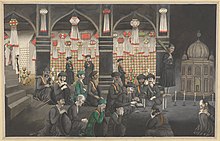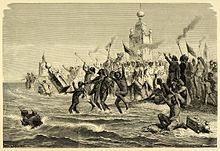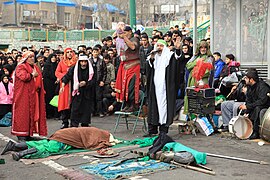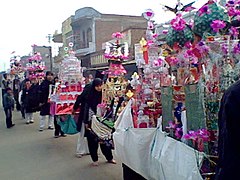Ta'zieh
| The ritual dramatic art of Ta'zīye | |
|---|---|
 Tazia carrying procession by Shia Muslims on Ashura in the Indian subcontinent (c. 1790-1800). The Tazia were immersed into the river or ocean. | |
| Country | [[Iran, Iraq and Lebanon[1]]] |
| Region | Near East, Asia, Australasia |
| Inscription history | |
| Inscription | 2010 |
| Part of a series on |
| Islamic culture |
|---|
| Architecture |
| Art |
| Clothing |
| Holidays |
|
| Literature |
| Music |
|
Theatre |
| Part of a series on |
| Husayn |
|---|
Ta'zieh
Depending on the region, time, occasion, religion, etc. the word can signify different cultural meanings and practices:
- In Iranian cultural reference it is categorized as Condolence Theater or Passion Playinspired by a historical and religious event, the tragic death of Hussein, symbolizing epic spirit and resistance.
- In South Asia and in the Caribbean it refers specifically to the Miniature Mausoleums (imitations of the mausoleums of Karbala, generally made of colored paper and bamboo) used in ritual processions held in the month of Muharram.
Ta'zieh, primarily known from the Iranian tradition, is a Shia Islam ritual that reenacts the death of Hussein (the Islamic prophet Muhammad's grandson) and his male children and companions in a brutal massacre on the plains of Karbala, Iraq in the year 680 AD. His death was the result of a power struggle in the decision of control of the Muslim community (called the caliph) after the death of Muhammad.[4]
Today, we know of 250 ta'zieh pieces. They were collected by an Italian ambassador to Iran, Cherulli, and added to a collection that can be found in the Vatican Library. Ta'zieh play texts were translated from Persian into French, by Aleksander Chodźko, the Polish orientalist, into Ukrainian by Ahatanhel Krymsky, Ukrainian orientalist, and into German by Davud Monshizadeh, Iranian Orientalist. Various other scripts can be found scattered throughout Iran.[5]
The origins

Ta'zieh as a kind of passion play is a kind of comprehensive indigenous form considered as being the national form of Iranian theatre which have pervasive influence in the Iranian works of drama and play. It originates from some famous mythologies and rites such as Mithraism, Sug-e-Siavush (Mourning for Siavush) and Yadegar-e-Zariran or Memorial of Zarir.[7][8] The ta'zieh tradition originated in Iran in the late 17th century. Mourning for Siavosh as reflected in literature is a manifestation of all the prominent characteristics of our Islamic Shabihkhani. "Some believe that Iman Hossein's tragedy as depicted in Taziah is the next recreation of the legend of Siavosh"[9]
There are two branches of Islam; the Sunni and the Shi'i. The Sunnis make up about 85-90% of Muslims, but the ta'zieh tradition is performed by Shia Muslims during the first month of the Muslim calendar, Muharram, one of the four sacred months of the Islam calendar.[10] The ta'zieh is performed each year on the 10th day of Muharram, a historically significant day for the Shia Muslims because that was the day of Hussein's slaughter. Each year the same story is told, so the spectators know the story very well and know what to expect. However, this does not negatively affect audience levels.[11]
A strong belief in the Muslim community was that nothing created by regular people could be better than the way Allah created it, so all other creation was deemed disrespectful. Because of this, there are not many accounts-visually or otherwise- of this religious tradition. During the tradition it was very important that all spectators knew the actors were not disrespecting Allah, so most often, the actors had their scripts on stage with them so it was clear that they were not trying to depict another person that Allah did not create.[10] The ritual was eventually banned by the authorities in Iran because the ritual was being exploited for political advances. Ta'zieh is not performed regularly in Iran and has not been seen at all in certain provinces of the region since 1920.[12] France was the first non-Muslim country that ta'zieh was performed in 1991. Since then, the tradition has been seen in non-Iranian cities like Avignon and Paris in France, Parma and Rome in Italy, and New York City.[13]
In Iranian culture
In Iranian culture it refers to condolence theater and
While in the West the two major genres of drama have been comedy and tragedy, in Iran, ta'zieh seems to be the dominant genre. Considered as Iranian opera, ta'zieh resembles European opera in many respects.[14]
The development of ta'ziyeh as a dramatic form
The appearance of the characteristic dramatic form of Persia known as the ta'zïye
The development of ta'ziyeh reached its peak during the Qajar period thanks, in particular, to the great interest shown by the Qajar Kings, especially Nasser al-Din Shah (1848-1896). A most important development during this period is that "due to popular demand," performances of ta'ziyeh were no longer restricted to the month of Muharram and the following month of Safar, but extended to other times throughout the year. In the beginning, there were only certain dates in the Shiite calendar when ta'ziyeh could be performed. For example, the ta'ziyeh of the martyrdom of Ali, the first Shiite Imam and the fourth caliph, was performed on the 21st of Ramadan, the day Ali died from a sword wound. Popular appreciation of this dramatic form encouraged the growth of the ta'ziyeh repertory. Other stories from the Islamic tradition as well as biblical stories and Iranian national legends were incorporated. Since staging a performance involved a great deal of effort, a ta'ziyeh group would usually perform in the same place for several days, mixing the Muharram repertory with what we can call the fringe ta'ziyeh plays. Among these plays, we finally come across comedies, or more accurately, satires, concerning various perceived enemies of the Shiites. In particular, these satires concentrated on Umar, Uthman, and Abu Bakr, the three caliphs who, according to popular Shiite belief, were instrumental in preventing Ali from becoming the first caliph/Imam after the death of Muhammad.[21]
Guriz or flashbacks in Ta'zieh
It is theoretically possible to incorporate any event, from the day of creation to the day of judgment, into the repertory of ta'ziyeh. This is possible through a very important theatrical device that played a crucial role in facilitating the importation of subjects foreign to the main topic into the ta'ziyeh plays without creating any technical or moral problems: guriz. The word guriz is the verbal noun of gurikhtan, which means, "to flee." In ta'ziyeh this word, combined with the aux-iliary verb zadan, acquired a very specific meaning: "to refer to the events of Kar-bala." In English "guriz zadan", could be replaced by "flashback" or "flash forward," as the case may be. The authors of ta'ziyeh plays, by utilizing guriz, created an opening for the introduction of non-Shiite plays into the ta'ziyeh repertory. They simply employed this theatrical technique as a digression: in the secular ta'ziyeh there is usually a glance at one of the events of Karbala, often toward the end of the play, but this varies depending on the action of the play. The device of guriz provided a valid pretext for producers to use stories other than the Shiite martyrdom tragedies to entertain people. Through the guriz, all human conditions are directly or indirectly related to the suffering and tragic death of the "Martyrs of Karbala," regardless of whether the story takes place before or after the Karbala massacre. The Cerulli collection, housed in the
Decline of Ta'zieh plays In Iran
The decline of ta'ziyeh began in response to the interference and opposition of several elements and forces. To begin with, during the last years of the Qajar rule, although ta'ziyeh never lost its popularity, the support of the court and the well-to-do started to wane, causing the ta'ziyeh performers to seek sponsorship from the lower strata of society. 'After Nasser al-Din Shah, the glory and the importance of ta'ziyeh gradually diminished but its popularity was conserved. The professional troupes which were newly formed toured the cities all year round and performed". The rural population did not enjoy the sophistication (or perhaps the decadence) of the more advanced urban society. They were definitely more interested in the traditional ta'ziyeh and had no interest in comical developments in their yearly mourning ritual.[22]
Women in Ta'zieh
Women were not considered active members of the Ta'zieh performance ritual. Almost all women in these rituals were played by young males, however on some occasions little girls under the age of nine were able to fulfill small roles.
Importance of the space
In Iranian Ta'zieh, the space is very important. Originally, Ta'zieh dramas, like other Western
Unlike most other theater traditions, especially Western theater traditions, the Ta'zieh stage and its use of props were minimalist and stark. All tekyehs are designed so that the Ta'zieh performance happens in-the-round to create a more intense experience between the actors and the audience.[26] This enabled spectators to feel like they were part of the action on stage and sometimes encouraged them to become physically active members of the performance; it was also not unusual for combat scenes to occur behind the audience.[27]
Costumes and character distinctions
Costumes for a Ta'zieh ritual are what is considered representational in terms of theater. They are not meant to present reality. The main goal of the costume design was not to be historically accurate, but to help the audience recognize which type of character they were looking at. Villains were the Sunni opponents of Imam Hussein. They are always dressed in red. The protagonists, family members of Hussein, were dressed in green if they were male characters.[5] Anyone about to die was in white. Women were always portrayed by men in all black.[4] One way to distinguish character besides the color of their costume is how they deliver their lines. The protagonists or family of Imam Hussein sing or chant their lines and the villains will declaim their lines. If a person is traveling in a circle on or around the stage, that meant they were going a long distance (usually represented the distance between Mecca and Karbala). Traveling in a straight line represented a shorter distance traveled.[5]
Animals in the tradition
Often animals were used in the performance of a Ta'zieh. Often performers of Ta'zieh were on horseback. Most men from the time they were young would train to be able to ride a horse because it was an honor in Persian culture to be part of the Ta'zieh, especially to play a character who rode horseback. There were often other animals used in the tradition as well. These other animals were: camels, sheep or sometimes even a lion.[5] Usually the lion is not real, and is just represented by a man wearing a mask of some sort.
Ta'zīya around the world

Shia
The artwork is a colorfully painted bamboo and paper mausoleum. This ritual procession is also observed by South Asian Muslims throughout present-day India, Pakistan and Bangladesh, as well as in countries with large historical South Asian diaspora communities established during the 19th century by indentured labourers to British, Dutch and French colonies. Notable regions outside of South Asia where such processions are performed include:
- British Guiana and Dutch Surinam ( now Guyana and Suriname)[29]
- Fiji[30]
- Trinidad and Tobago[31][32]
- Jamaica[33]
In the
Since 1790 in
During the colonial-era in British India, the ta'zieh (ta'zīya) tradition was not only practiced by Shia Muslims and other Muslims but joined by Hindus.
Gallery
-
Ta'zieh in Tajrish, Tehran
-
Ta'ziye in Shiraz Arts Festival,1977
-
IndianShia
-
Women Attending a Ta'Zieh 1800s
-
Persian Tekyeh for Ta'Zieh
-
Ta'azieh in Tehran
-
A man acting asUmar ibn Sa'adwhose army set fire to Imam Hussain's family tents, Iran
-
Ta'zieh in Iran, mourning of Muharram
-
All actors use scripts during performance
-
Ta'zieh (2017) in Iran
-
Ta'zieh (2003) in Iran
See also
- Hosay
- Islam in Iran
- Tekyeh
- Muharram
Notes
- ^ also spelled asTa'zïye, Ta'zīya, Tazīa, or Ta'ziyeh
References
- ^ "UNESCO - Intangible Heritage Home".
- ISBN 978-1-0152-8641-2.
- ISBN 0-8147-1375-0.
- ^ a b c d Chelkowski, Peter (2003). "Time Out of Memory: Ta'ziyeh, the Total Drama". Asia Society. Retrieved 11 November 2017.
- ^ a b c d Beeman, William O. "Theatre History #27: Learning about Ta'Ziyeh with Dr. William O. Beeman." Audio Blog Post. Theatre History. HowlRound. 27 Mar 2017.
- ^ "Shi'a Muslims Mourning Before a Ta'ziya". Google Arts & Culture. Retrieved 2021-11-30.
- .
- ISBN 978-1519731791.doi:10.6084/m9.figshare.3511154 & doi:10.5281/zenodo.59379.svg
- ^ Fadaie, Seyed Hossein (2007). Manifestation of Religion in Western Drama. Namayesh. p. 182.
- ^ ISBN 978-0-415-22727-8.
- ^ Emami, Iraj (1987). The Evolution of Tradition Theatre and The Development of Modern Theatre in Iran. Scotland: University of Edinburgh. p. 48.
- ^ JSTOR 43620726.
- ^ "TA'ZIA". Encyclopaedia Iranica. July 15, 2009. Retrieved September 18, 2017.
- ^ Iranian performance of Beethoven's 9th Symphony (BBC Persian)
- S2CID 57568526.
- ^ Marshall, Lee (2003-07-14). "Feature: Abbas Kiarostami's theatre debut". the Guardian. Retrieved 2022-01-29.
- ISSN 0362-4331. Retrieved 2023-09-15.
- ^ Beeman, William O.. (2003). The 'Taziyeh of Hor, The Taziyeh of the Children of Moslem, The Taziyeh of Imam Hussein'. Theatre Journal. 55. 359-362. 10.1353/tj.2003.0053. <
- ^ Ghaffari, Rabeah, The Troupe (Documentary), Laura Aswad, William Beeman, Mohammad Ghaffari, retrieved 2023-09-15
- ^ Iranian Theater Propagates Shiism
- ^ Anvar, Iraj. “Peripheral Taʿziyeh: The Transformation of Taʿziyeh from Muharram Mourning Ritual to Secular and Comical Theatre.” Peripheral Taʿziyeh: The Transformation of Taʿziyeh from Muharram Mourning Ritual to Secular and Comical TheatrE, vol. 49, 2005, pp. 61–67. JSTOR, www.jstor.org/stable/4488681.
- ^ a b Anvar, Iraj. “Peripheral Taʿziyeh: The Transformation of Taʿziyeh from Muharram Mourning Ritual to Secular and Comical Theatre.” Peripheral Taʿziyeh: The Transformation of Taʿziyeh from Muharram Mourning Ritual to Secular and Comical TheatrE, vol. 49, 2005, pp. 61–67. JSTOR, www.jstor.org/stable/4488681.
- ^ Mottahedeh, Negar. "Ta'ziyeh; Karbala Drag Kings and Queens". Iran Chamber.
- ^ Idem. "Narrative Painting and Painting Representation in Qajar Iran".
- ISBN 978-1-9064-9-751-4.
- ^ Chelkowski, Peter (2003). "Time Out of Memory: Ta'Zieh, The Total Drama". Asia Society. Retrieved 11 November 2017.
- ^ "THE PASSION OF HOSAYN". Encyclopedia of Iranica. Retrieved 2008-01-19.
- ^ ISBN 978-0-520-96108-1.
- ^ Specifically, Trinidad Sentinel 6 August 1857. Also, Original Correspondence of the British Colonial Office in London (C.O. 884/4, Hamilton Report into the Carnival Riots, p.18)
- ^ Peasants in the Pacific: a study of Fiji Indian rural society By Adrian C. Mayer
- ^ Jihad in Trinidad and Tobago, July 27, 1990 By Daurius Figueira
- ISBN 978-0-8122-3683-5.
- ^ Shankar, Guha (2003) Imagining India(ns): Cultural Performances and Diaspora Politics in Jamaica. Ph.D. Dissertation, University of Texas, Austin pdf Archived 2008-12-19 at the Wayback Machine
- ^ "Truth and Justice Commission 2011 Report Volume 1" (PDF). Page 174. Government of Mauritius. Retrieved 2021-07-02.
- ^ "Yamse festival in Mauritius". Lonely Planet. Retrieved 2021-07-02.
- ^ Toorab, Reshad. "Célébration du Yamse : Moidine Lindor, le doyen, perpétue la tradition". Defimedia. Retrieved 2016-10-16.
- ^ Bachyul Jb, Syofiardi (2006-03-01). "'Tabuik' festival: From a religious event to tourism". The Jakarta Post. Retrieved 2007-01-27.
- ^ Beyond Hindu and Muslim: Multiple Identity in Narratives from Village India By Peter Gottschalk, Wendy Doniger
- ^ Toleration through the ages By Kālīpada Mālākāra
- ISBN 978-0-253-22044-8.
Further reading
- William O. Beeman, Iranian Performance Traditions, Costa Mesa, CA: 2011
- Bahram Bezae'i, Namayesh dar Iran, Tehran: 1345/1966
- Peter Chelkowski, Ta'ziyeh: Ritual and Drama in Iran, New York 1979
- Willem Floor, Theatre in Iran, Washington, D.C.: 2005
- Aleksander Chodźko, Théâtre persan, choix de Téaziés ou drames traduits pour la première fois de persan par A. Chodźko, Paris 1878.
- Ahatanhel Krymsky, Pers’kyj teatr, Kyjiw, 1925.
- Davoud Monchi-Zadeh, Taʿziya : Das persische Passionsspiel, mit teilweiser Übersetzung der von Litten gesammelten Stücke, Stockholm: Skrifter utgivna av K. Humanistiska Vetenskapssamfundet I Uppsala, 1967
External links
- Passion play an article by Encyclopædia Britannica online
- The passion (ta¿zia) of Husayn ibn 'Ali Archived 2007-10-21 at the Wayback Machine by Peter Chelkowski, an article of Encyclopædia Iranica.
- Nasser Taghvaee's documentary: Tamrin e Akhar (BBC Persian)
- Abbas Kiarostami on Tazieh (BBC Persian)
- Ta'zieh, the Persian Passion Play
- Ta'zia by Peter Chelkowski in Encyclopædia Iranica
- Combining creed with culture
- The Legality of making figurine effigy (Taziyah) of the shrine Archived 2012-11-26 at the Wayback Machine
- https://www.era.lib.ed.ac.uk/bitstream/handle/1842/7362/381673. Archived 2012-11-26 at the Wayback Machine
- [1]












